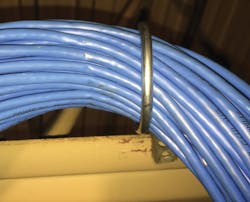Installers must consider more than just the cable in order to comply with bend-radius requirements. Support hardware, connectivity, and other equipment matter too.
The requirement for maintaining proper bend radius is defined in the Generic Telecommunications Cabling for Customer Premises standard, ANSI/TIA-568.0-D. The standard’s “D” revision was published in 2015 and specifies that the minimum inside bend radius for balanced unshielded twisted-pair cable is four times the overall cable diameter. The previous-generation “C” revision of the standard also specified a 4x OD minimum bend radius for cable. For cord cable, the minimum bend radius also is 4x OD; that’s an increase from the 1x OD requirement specified in the 568.0 standard’s “C” revision. TIA-568.0-D also specifies a 25-mm (1-in) minimum inside bend radius for optical fiber cord cable. This article, however, will focus on the bend radius requirements for twisted-pair cable and twisted-pair cordcable.
When an installer is working with twisted-pair cable in the horizontal portion of the cabling system, that installer must be concerned with more than just the cable in order to comply with the standard’s bend-radius requirement. Specifically, the support system or hardware used along the horizontal pathway can affect bend radius, as can the connectivity and termination area for the horizontalcable.
The pinching of these cables, which is a result of the apparatus used for support, put the cables in violation of ANSI/TIA-568.0-D’s bend-radius requirement.
J-hooks and other supports
nVent, which provides the Caddy brand of cable-support hooks, emphasizes that these cable-management tools can impact an installation’s bend-radius compliance. In a document titled “Bend radius overview reference sheet,” the company explains, “During installation, cables are bent or flexed in order to accommodate various environmental conditions such as getting around obstacles and making elevation or directional changes. Minimum bend radius refers to the smallest radius the cable is allowed to be bent without degrading performance.” The document refers to the 4x requirement in ANSI/TIA-568.0-D, then explains, “For a typical Cat 6A cable (about one-fourth-inch diameter), bend radius for appropriate cable supports such as a J-hook need to be at least 1 inch. This standard is meant to ensure quality performance and connectivity, support technological innovation, and provide superior, globally acceptedproducts.”
nVent then further explains that cable manufacturers “generally require a proper bend radius and do not recommend cables being supported by non-continuous supports that cause indents and creases in the cable jacket. Such indents or creases may affect cable performance, or in worse situations, the cables can be damaged while being pulled during installation—especially if there is a directional change of the cablebundle.”
In its document “Premises cable installation guideline,” Superior Essex refers to bend radius dozens of times. One reference reads, “When planning the route, be sure to … avoid any other possible hazards such as pinch points, sharp angles, heat sources, etc. … The minimum cable bend radius must be maintained throughout the cableroute.”
With that requirement in mind, nVent’s bend-radius reference-sheet document states, “Not all non-continuous cable supports provide the proper bend radius, so it is important to make sure your data infrastructure includes supports that have the proper bendradius.
“In order to determine which non-continuous cable supports offer the proper bend radius, multiple tests have been conducted on various manufacturers’ products … In order to find out how manufacturers measured up in bend radius, an installation test was conducted with 60 Category 6 cables in horizontal to vertical configuration. The cables were supported by J-hooks in 5-foot spacing and 1-foot sag, left in position for 24 hours. The cables were then offset from the J-hook in order to examine the cable jackets fordeformation.”
Several J-hook products showed deformation, nVent reports. Specifically, cables suffered from pinch points. Other testing on these same sets of cables obtained an actual cable bend-radius reading. As nVent explains, “A Mitutoyo Contracer C-3000 machine was used to obtain a cross-section profile from different manufacturers’ supports. The equipment also provides bend radius readings once trace lines are available.” From that set of testing, nVent reports, its own Caddy brand J-hooks provided a bend radius greater than 4x the cable diameter, while others did not. Testing on one hook revealed a bend radius as small as 0.04 inches, nVentstates.
While it’s predictable that a document produced by nVent shows favorable results for the examination and testing of its own products versus others, the larger point is worthy of merit on its own: In a real-world application, the choice of a horizontal cable support system can affect standardcompliance.
Supporting applications
The reason for specifying bend radius in a standard to begin with is to ensure the installed cable is not physically compromised, and therefore is able to support the applications that will operate over it. As such, the bend-radius standard and bend-radius best practices are very much “applications” issues in addition to being installation issues. Being a 4x multiple of the cable’s outside diameter, the bend radius specification also is directly tied to that characteristic of a cable. Over the past couple years, manufacturers of twisted-pair cable have reduced their products’ OD in efforts to address installation issues like pathway congestion while simultaneously ensuring the cables remain capable of supporting their intendedapplications.
In 2018 Superior Essex reduced the OD of its 10Gain XP Category 6A cable to 0.25 inches. At the time of the cable’s introduction, the company’s director of global product management for premises copper products, Amir Sekhavat, commented that the cable “offers significant size advantages in tight spaces and less environmental impact without compromising on performance orsafety.”
Also in 2018 General Cable introduced a smaller-diameter GenSpeed 10 Category 6A cable. The company said the smaller-diameter cables offer “an improved design with enhanced performance and maneuverability. Smaller, lighter and more flexible … GenSpeed 10 allows for increased cabling fill capacity, smoother cable routing and easier installation. Reduced size translates to simplified and more-efficient cablemanagement.”
Belden’s small-diameter Category 6A cable, 10GXS, is available with bonded or unbonded pairs. Belden has offered bonded-pair technology for twisted-pair cables for more than 20 years. Belden’s line manager for copper-based products Matt Baum explained that although the 568.0-D standard specifies the 4x-OD bend radius, Belden’s 10GXS cables with bonded pairs can be bent to 1x the OD without compromising the cable’s performance. The strength and durability of bonded pairs also permits installers to use a higher pulling tension than they could get away with using on cables with unbonded pairs, headded.
Baum pointed out that Belden also uses bonded pairs in its patch cords. “When you think about people shoving patch cords into tight spaces, there’s a real possibility of kinking them,” hesaid.
Field-terminable plugs
Belden has offered bonded-pair smaller-diameter Category 6A cables since 2016. But in 2018 it introduced a product to its REVConnect portfolio that relates to both tight spaces and horizontal-cable termination. The REVConnect system, introduced in 2016, uses a single termination method for all RJ45 connections. It uses a universal core; installers terminate a jack or a plug to the same coreinterface.
As field-terminable plugs have grown in popularity, many IP cameras and some digital-signage devices have presented a specific challenge for installers: the device’s RJ45 port exists in a tight space, making the use of a field-terminable plug impractical, because of the plug’s overall dimensions. Additionally, the angle at which a field-terminated cable would enter the device’s port could raise bend-radiusconcerns.
Some manufacturers have responded to this challenge by introducing angled field-term plugs. For applications in which an angled plug doesn’t solve the problem, Belden offers the REVConnect FlexPlug. The company says its FlexPlug “takes the compatibility questions out of connecting endpoint devices by working with any Internet of Things (IoT) device that uses an RJ45 plug. It enables the REVConnect termination to be deployed in applications where the size of a typical field-terminated plug inhibits direct connection to IoT devices with size and cable routingconstraints.”
In popular nomenclature, the FlexPlug may be referred to as a dongle. Belden’s Baum explained, “One end has a factory-terminated patch-cord plug. On the other end of the standard 18-inch bonded-pair patch cable is the REVConnectcore.”
According to Belden, the FlexPlug “eliminates the need for a jack, biscuit box, and patch cord for fast installation with fewer components and lower materialcosts.”
For cabling-system specifiers, designers and installers, devices like J-hooks and field-terminable plugs can be critical elements in ensuring an installation is fully standard-compliant. The requirement to maintain proper bend radius could be violated in any number of places throughout a cable run, and such a violation could be overlooked. Attention to detail like bend-radius compliance equips user organizations with an infrastructure that is ready for day two of network operations.

